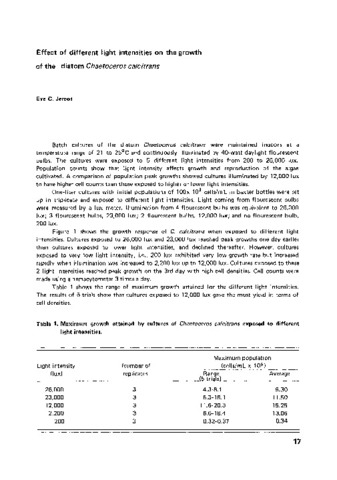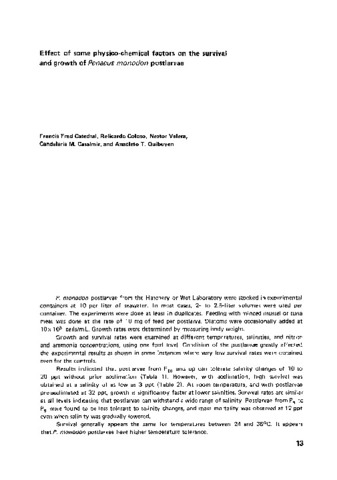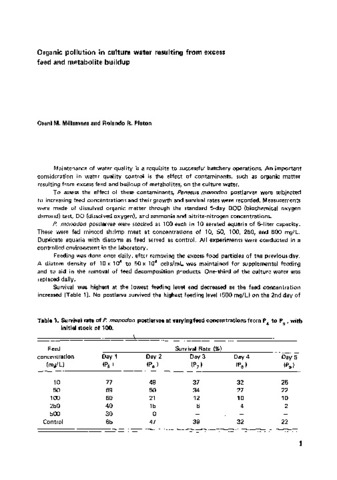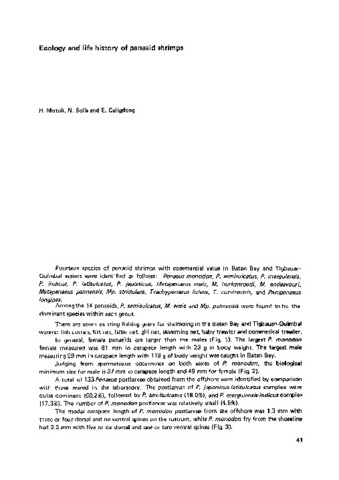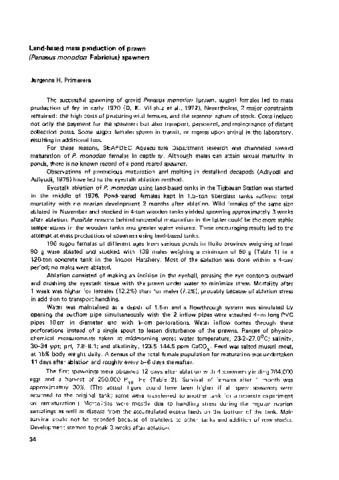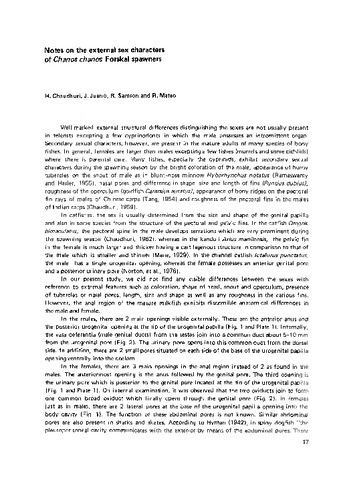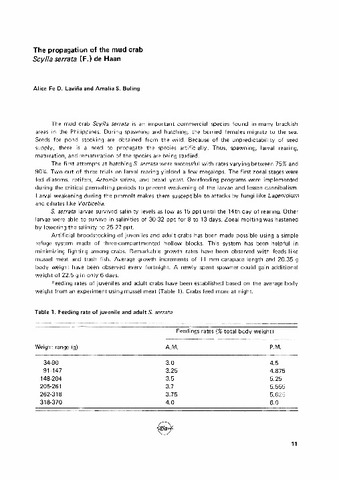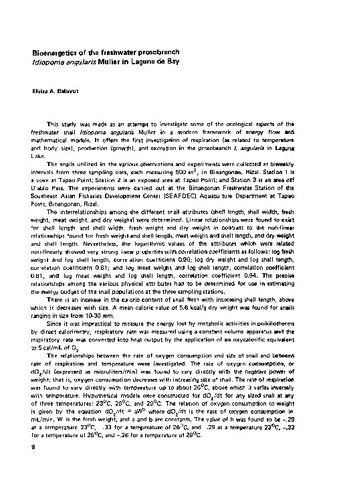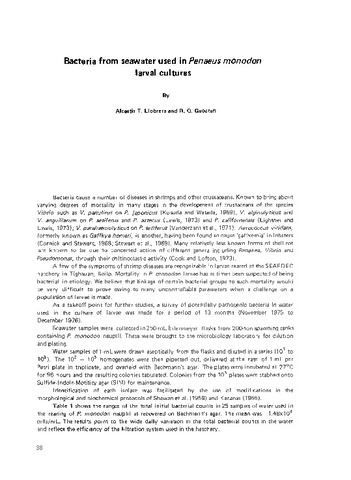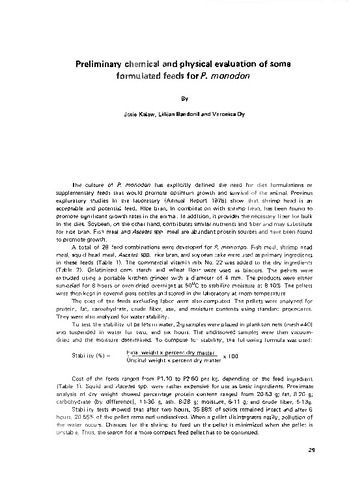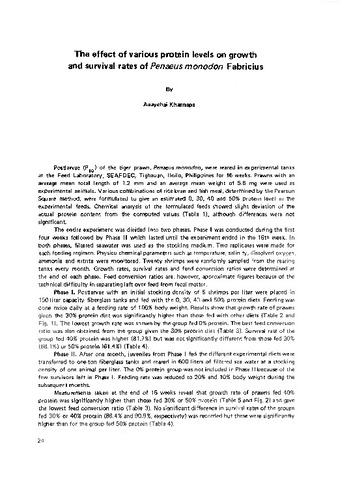Quarterly Research Reports: Recent submissions
Now showing items 101-120 of 125
-
Effect of nitrite, ammonia, and temperature on P. monodon larvae
(Aquaculture Department, Southeast Asian Fisheries Development Center, 1977)P. monodon larvae were studied for the effects of temperature, ammonia, and nitrite on survival. Toxicity levels of nitrite were found to vary with larval stage. Larvae could tolerate ammonia up to about 10 ppm, with the ... -
Notes on ovarian rematuration of ablated sugpo (prawn) Penaeus monodon Fabricius
(Aquaculture Department, Southeast Asian Fisheries Development Center, 1977)To what extent spent P. monodon females can remature and spawn successive broods is an important question in terms of recycling spawners in a commercially viable operation. Corollary to this is the quantity and quality of ... -
Effect of different light intensities on the growth of the diatom Chaetoceros calcitrans
(Aquaculture Department, Southeast Asian Fisheries Development Center, 1977)Batch cultures of C. calcitrans were maintained indoors at a temperature range of 21 to 25 C and continuously illuminated by 40-watt daylight fluorescent lights. Cultures were exposed to 5 different intensities from 200 ... -
Effect of some physico-chemical factors on the survival and growth of Penaeus monodon postlarvae
(Aquaculture Department, Southeast Asian Fisheries Development Center, 1977)Growth and survival rates of P. monodon postlarvae were examined at different temperatures, salinities, and nitrite and ammonia concentrations, using one feed level. Condition of postlarvae greatly affected the experimental ... -
Organic pollution in culture water resulting from excess feed and metabolite buildup
(Aquaculture Department, Southeast Asian Fisheries Development Center, 1977)Penaeus monodon postlarvae were subjected to increasing feed concentrations and their growth and survival rates were recorded. Measurements were made of dissolved organic matter, and ammonia and nitrite-nitrogen concentrations. ... -
Ecology and life history of penaeid shrimps
(Aquaculture Department, Southeast Asian Fisheries Development Center, 1977)Fourteen species of penaeid shrimps with commercial value in Batan Bay and Tigbauan-Guimbal waters were identified as follows: Penaeus monodon, P. semisulcatus, P. japonicus, Metapenaeus ensis, M. burkenroadi, M. endeavouri, ... -
Land-based mass production of prawn (Penaeus monodon Fabricius) spawners
(Aquaculture Department, Southeast Asian Fisheries Development Center, 1977)The first spawnings were obtained 12 days after ablation with 4 spawners yielding 784,000 eggs and a harvest of 250,000 P10 fry. Survival of females after 1 month was approximately 30%. Mortalities were mostly ... -
Survival rates of different postlarval stages of Penaeus monodon Fabricius
(Aquaculture Department, Southeast Asian Fisheries Development Center, 1977)The objective of this study is to determine survival rates of different postlarval stages upon stocking in the Leganes ponds. Twelve 3m x 2m x 2m suspension nets made of nylon cloth (mesh size = 0.1 mm) were set up in a ... -
Notes on the induced maturation and spawning in four-month-old Penaeus monodon Fabricius by eyestalk ablation
(Aquaculture Department, Southeast Asian Fisheries Development Center, 1977)The ablation technique consisted of making an incision across the eyeball to allow free flow of fluids while holding the prawn under water, squeezing the eyeball contents outwards, and pinching hard the eyestalk tissue. ... -
Notes on the external sex characters of Chanos chanos Forskal spawners
(Aquaculture Department, Southeast Asian Fisheries Development Center, 1977)In this study, the authors did not find any visible differences between the sexes with reference to external features such as coloration, shape of head, snout and operculum, presence of tubercles or nasal pores, length, ... -
The biology and control of Caligus sp., an ectoparasite of the adult milkfish Chanos chanos Forskal
(Aquaculture Department, Southeast Asian Fisheries Development Center, 1977)One unidentified species of copepod belonging to the genus Caligus of the family Caligidae was found to infest the adult milkfish broodstock. To control the parasites infesting the adult milkfish, tests were made using the ... -
The propagation of the mud crab Scylla serrata (F.) de Haan
(Aquaculture Department, Southeast Asian Fisheries Development Center, 1977)The mud crab Scylla serrata is an important commercial species found in many brackish areas in the Philippines. During spawning and hatching, the berried females migrate to the sea. Seeds for pond stocking are obtained ... -
Bioenergetics of the freshwater prosobranch Idiopoma angularis Muller in Laguna de Bay
(Aquaculture Department, Southeast Asian Fisheries Development Center, 1977)This study was made as an attempt to investigate some of the ecological aspects of the freshwater snail Idiopoma angularis Muller in a modern framework of energy flow and mathematical models. It offers the first investigation ... -
Biology and farming of the green mussel Mytilus smaragdinus
(Aquaculture Department, Southeast Asian Fisheries Development Center, 1977)Biological investigations were carried out in Sapian Bay, Capiz from November 1975 to December 1976 with samplings conducted fortnightly. Histological studies on the gonad reveal a high percentage of ripe and spent females ... -
Bacteria from seawater used in Penaeus monodon larval cultures
(Aquaculture Department, Southeast Asian Fisheries Development Center, 1977)Bacteria in the seawater used in P. monodon hatchery operations were isolated on Bachmann's agar. The total plate counts in 25 isolations ranged from 1.0 - 5.0 x 102 to 5.1 -10.0 x 105 cells per ml. ... -
Reduction in Chaetoceros populations by furanace
(Aquaculture Department, Southeast Asian Fisheries Development Center, 1977)One of the most promising prophylactic agents being tested to control Penaeus monodon larval diseases is furanace (6-hydroxymethyl-2 2(5-nitro-2-furyl) vinyl pyridine). To evaluate further its suitability as a chemotherapeutic ... -
Effects of furanace on Brachionus
(Aquaculture Department, Southeast Asian Fisheries Development Center, 1977)Tiger prawn P.monodon) larvae utilize Brachionus a rotifer, as food in the Zoea 3 and mysis stages when they change from an herbivorous to an omnivorous diet. The present work aims to show the effects of furanace on the ... -
Preliminary biological evaluation of some formulated feeds for P. monodon
(Aquaculture Department, Southeast Asian Fisheries Development Center, 1977)Rice bran is widely used by fish farmers as supplementary feed while soybean cake is used both as feed and as fertilizer in fishponds. Both fish meal and shrimp head have been found acceptable as feed ingredients. However, ... -
Preliminary chemical and physical evaluation of some formulated feeds for P. monodon
(Aquaculture Department, Southeast Asian Fisheries Development Center, 1977)The culture of Penaeus monodon has explicitly defined the need for diet formulations or supplementary feeds that would promote optimum growth and survival of the animal. A total of 28 feed combinations were developed for ... -
The effect of various protein levels on the growth and survival rates of Penaeus monodon Fabricius
(Aquaculture Department, Southeast Asian Fisheries Development Center, 1977)Postlarvae of tiger prawns, P. monodon , were fed with various protein levels of 0; 30; 40 and 50%, fish meal and rice bran were combined and pelletized for 16 wks. Prawns used had an average mean length of 1.2 mm and an ...




